Over the years I have amassed quite a bit of jewelry. Some noteworthy pieces inside my collection include an imitation pearl necklace from my maternal grandmother that I wore as a kid due to my obsession with Audrey Hepburn or the crystal prism earrings I lifted from my mom’s collection that remind me of her every time I wear them. Yet there is one small item that remains very personal to an intrinsic part of my identity.
See one day during an Asexual and Aromantic Conference during WorldPride 2019, there was a small white table on which a collection of small black rings in an array of sizes stood waiting to be picked up. On that day I selected a simple black band, hematite in color, androgynous in form, neither too feminine or masculine, a little loose yet sturdy and solid around the middle finger on my right hand.
Within the queer community there is a long and complex history of coding, from flagging— the handkerchief system used to indicate sexual preferences and kinks— to the subtle subtextual portrayal of LGBTQ+ characters in film, restricted to subtext due to Hollywood’s homophobic censorship policies. In a sense, coding has evolved in reaction to hostility and as a form of queer solidarity, a nod from some queer folx to others saying that even if you do not or cannot say who you are out loud that we recognize and acknowledge you any way.
For some this language of coding is found in fashion, as seen in joking remarks about flannel being an iconic staple of lesbian style or cuffed jeans and jean jackets for bisexual culture. For the asexual or ace community, whose status as a community is relatively young in comparison to other facets of queer communities and whose visibility is a little subtle, one of the small signs we have adapted is a black ring on the middle finger of the right hand.
While the history around the origins of the ace ring is a little murky, one theory about this particular placement includes the decision to wear it on the right hand so as not to clash with the engagement ring typically worn on the left hand within most Western countries, while other possible reasons include a way of declaring self-partnership with oneself rather than with other person (though many aces can experience romantic attraction and do have romantic partnerships.)
For me the black ring stands as a way for me to affirm my identity, whether in solidarity with other aces who also wear and recognize the symbol, or as a safe way of rebelling in a household or world that does not recognize my queer identity. As a woman of Slavic descent, I come from a culture where the ticking clock for marriage generally starts at twenty-five and the pressures for heterosexual partnership are reinforced from day one. As a person who experiences attraction to people of various gender identities, even if rarely, homophobia dictates that I keep my romantic attractions to myself in order to protect my own sense of personal comfort within my home while acephobia dictates that I do not exist at all.
The law of compulsory allonormativity (not unlike Adrienne Rich’s coined “Compulsory Heterosexuality”) states that all people must experience sexual attraction or else be considered something “foreign” or “strange.” In various moments when I have come out as ace, I have been called a baby, a prude, a “snowflake,” and in one particularly hurtful and intense interaction with a family member I came out to, a “f-cking weirdo.” Online the language directed if not personally at me, then at my asexual community is usually frigid, cold, and inhuman. To all the straight and queer individuals who have questioned me on my sexuality, saying that I just need to have sex (as if that would change my sexuality) let me ask you: Who would want to go through all that for an identity that is not valid or real?
Some days it feels harder to say I am asexual than bi, because the invisibility surrounding my community is a vicious net that slices us every time a canonically asexual character is erased on screen or someone implies we are not queer enough to be part of the LGBTQ+ community. And one those hard days, when my family starts talking around me about needing to find a boyfriend/husband, or society says I need to fundamentally change my nature in order to be “normal,” I hold on to my black ace ring like an engagement ring, a quiet commitment to myself, saying that I am valid and enough on my own.
Michele Kirichanskaya (she/her) is a queer freelance journalist from Brooklyn, New York. Currently studying at the New School, when she is not writing, she is reading, watching an absurd amount of cartoons and other pop culture shows, and creating content for platforms like The Mary Sue, GeeksOUT, and more. You can find her on Twitter at @MicheleKiricha1






